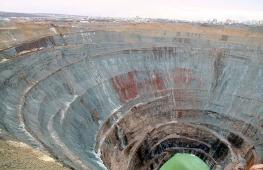Profile square pipe: application, advantages, stages of production
Figure: 136. Development of the transition from rectangular to circular section:
a - front view; b - side view; c - plan; d - auxiliary plotting of heights, d - sweep
Large transitions are made from four paintings, each of which is a transition wall. In this case, an approximate sweep of the transition walls will be performed as a sweep of the transition from a rectangular to a rectangular section. The size of the top base of each wall will be
If the transition is small, then it can be made from one whole picture.
The sweep of such a transition is performed according to (the method of dividing the figure into auxiliary triangles. On a separate sheet of roofing steel along given dimensions draw a front view (Fig. 136, a), a side view (Fig. 136, b) and a plan (Fig. 136, e).
Divide the plan with construction lines into separate triangular sections that are bent and into sections that remain flat. The joint line - folded joint - units are placed on a wide wall, as shown in Fig. 136, c. The areas of the symmetrical half of the scan are marked with the numbers 1, 2, 3, 4, 5 and 6. The construction of the scan of the picture is begun from section 1. For this, the true size of the bd line is laid, equal to the MK line taken from the side view. From point d at an angle of 90 °, draw a straight line and lay a segment dG on it, the true size of which is taken from the plan.
Points c and d are connected, the first section is obtained - a sweep triangle 1. A second section is attached to this triangle - triangle 2 on three sides - vG, vb and 6G. Side bG is obtained from the construction of triangle 1. Side eb is equal to 3.14 x d / 4, and side bG is taken from the auxiliary construction of triangle 3 (Fig. 136, d). To do this, we postpone the NG side according to the size taken from the plan. At point H, we draw a perpendicular line and set aside the segment Hb, the true value of which is equal to the line EZ (Fig. 136, a). We connect points b and D and we get an inclined line 6G, equal to the true value of the bG line of triangle 2 and the adjacent triangle 3. We construct triangle 2 by serifs of the compass, as shown in the figure. Then we attach sections of triangles 3 and 4 to the section of triangle 2. To do this, from point b with a radius equal to the bG line, we make a notch with a compass and from point G - a second notch with a radius equal to the BG line - the given width of the lower base of the transition. They will intersect at point B. We draw lines bB and cD, we get sections of triangles 3 and 4.
Next, to sections 3 and 4 we attach a section - a triangle 5. To do this, find point a by ticking with a compass from point b with a radius ba equal to 3.14 x d / 4 and a radius Ba equal to cG. Connecting points B, a and b, and straight, we get triangle 5.
To the section of triangle 5 we attach a section of triangle 6. To do this, from point a with radius ap equal to the IL line (from Fig. 136, b), we draw a notch and from point B with radius Br equal to half the length of the lower base of the transition - the second notch. Their intersection will be point P. Draw the center line pO. The resulting shape will be half of the transition sweep. The second half of the sweep will be symmetrical to the first, as shown in Fig. 136, d.
Points c, b, a, d, c will lie on an arc whose radius is equal to Oa. Center O, lying on the continuation of the axial line Ra of the sweep, is found by the intersection of the lines Ra and Nb. To the resulting scan, allowances for folds are added and flanging on the flanges, the material is cut and made from the transition pattern.
There is an easier way to approximate the development of a sweep of the transition from rectangular to circular sections.
Despite the fact that this method is less accurate than the above, it is often used in practice.
The transition is unfolded as a frustum unfolded. For this, a lateral view of the cone is built. The length of the lower base of the cone is determined by dividing the perimeter of the rectangular part of the transition by 3, 14, i.e. (2A + 2B) / 3.14. The value calculated in this way will be equal to the diameter of the circle, the length of which is equal to the specified perimeter.
The length of the upper base of the cone is the diameter - d. The height of the lateral view of the cone is equal to the height of the transition - h.
The sweep of the transition is done in the same way as the sweep of the truncated cone (Fig. 129).
To the resulting dimensions, an allowance for folds and flanging on the flanges is added and the entire development is drawn.
Cutting out the material and making the transition are performed as indicated above.
Depending on the size of the transition, it can be made entirely or from two or four parts.
With the word "pipe", an object with a circular cross-section usually appears in the imagination. Such a stable association does not make it possible to imagine that in addition to round pipes, there are square and rectangular steel pipes. After all, household pipelines familiar to us are made of elements with a circular cross section. Profile racks are used only for the installation of metal structures. How they are made, what advantages they differ, this article will tell.
Sizes of workpieces can be different
The advantages of round designs
To understand why you need shaped pipes, we will figure out why this building material is most often produced with a round section. This is explained by the following reasons:
- The manufacture of such a structure is technologically justified. If you take a sheet of Whatman paper or a newspaper and begin to fold them, then they themselves will take the shape of a cylinder. The same happens with sheets of tin, which are then used to make the components of large-diameter collectors. After that, the seam of the rolled sheet is connected by welding and a finished product is obtained.
- Circular piping has a minimum surface area that creates a maximum internal volume. The result is the highest throughput and the most economical material consumption.
Transportation of liquids and gases is carried out through round collectors. The rounded surface of the lines best withstands external and internal pressure. This confirms that with the lowest material consumption, high structural strength is ensured.

Pipes round section have a number of advantages over other profiles
Profile pipes
Material disadvantages
Steel rectangular profiles are characterized by different properties. They are also used in the construction of household networks, but such use cannot be considered economically profitable and technically reasonable. A pipeline from elements of such a section is made in exceptional cases. This selectivity is explained by the following reasons.
- Profiled steel rectangular pipes are characterized by a smaller internal volume. This means that a larger volume of liquid is pumped through one running meter of a round water supply system than through the same section of rolled products of a square or rectangular cross section.
- Geometric nets are only able to withstand external bending, torsion and tensile loads. But such structures do not withstand internal loads.
- A branch pipe with corners is always heavier than the same rounded part. As a result, the weight of collectors made of square elements is larger than heating mains with a circular cross-section.
Most plumbers for these reasons alone will deliberately refuse to use steel pipes of rectangular cross-section for the installation of a water supply or sewage system, even if they comply with GOST.
Advantages of profile blanks
Despite some disadvantages, steel pipe profile section is highly appreciated by installers of metal structures. They consider it ideal for assembling such structures. The advantages of such material are listed below.
- The weight of a steel hollow rectangle is better when compared to the weight of a bar of the same kind. Weight of one running meter such a riser with a cross-sectional area of \u200b\u200b23x10 cm is equal to 38 kilograms. The weight of an all-metal steel beam of the same section is 1000 kilograms.
On a note! The strength of structures with a rectangular cross-section under bending load is not inferior to the strength of all-metal beams.
- Compared to solid metal bars, the profile is easier to cut and deform into a non-linear part. This is done using a conventional pipe bender, not a forging press.
- Hollow products sell for less than solid rods. Ultimately, the cost of the assembled metal structure decreases.
Varieties of rectangular pipes
These products should be used with caution despite their attractive properties. The reason is that different profiles are required for specific tasks. To understand which of them will be needed in a particular case, it is important to familiarize yourself with the assortment and manufacturers of steel rectangular pipes.
On a note! The classification of this product is based on the method of its manufacture.
The range of profile elements is divided as follows:
- hot rolled products;
- cold rolled blanks;
- welded structures.
Products made by cold and hot rolling are not used as often as welded elements. The disdain for a more durable rolled product is explained by the technology of manufacturing such profiles. Therefore, choosing its type, find out the parameters and technology for the manufacture of blanks.
Manufacturing methods
Profile rental
Products of square and round sections are produced by hot or cold rolling. The first stages of the two technological processes look the same.

- due to the complexity of the technological process, the resulting products are more expensive than welded elements;
- significant weight of workpieces, because rolled structures have a large wall thickness - during hot rolling it can reach 7.5 cm;
- the advantage of a seamless structure over a pipe with a seam appears only when it withstands internal loads; both products carry external loads equally.

Assembly of steel structures from profiled steel elements
Hence the conclusion that rolled profiles are inferior in properties to the welded version.
Welded pipes
For the production of welded elements, a special machine is used for forming and welding sheet blanks. The benefit is that such a device can be placed in any suitable place.
Manufacturing welded pipe occurs in the following order.
- The sheet blank (strip) is wound on a special drum.
- The free edge of the steel blank is fixed on the rolls of the machine.
- The machine turns on, the sheet is pulled through the forming area, bending into a square profile.
- The folded sheet is directed into a special chamber containing an inert gas argon.
There the profile joint is welded.
Note! Any length of product can be produced using this automated process. This is another benefit of welded technology.
The third benefit is that when this way there is no tempering stage for pipe production It is needed to eliminate internal stress in workpieces that have been deformed on the rolling machine.
As you can see, the welded structure has advantages over the rolled profile. It is considered beneficial, both from the standpoint of the user and the standpoint of the manufacturers of this product. It's good when there is a choice!
Add to bookmarks
Profile square pipe: application, advantages, stages of production
One of the most popular types of rolled metal products is the so-called profile pipe, especially of square and rectangular cross-section.
Profile pipes are used where strength is needed.
Areas of application of square and rectangular shaped pipes
Pipes that have a square or rectangle in cross-section with rounded edges are widely used in industrial and especially civil construction when erecting columns of buildings, various towers, towers, and supports. The presence of flat edges simplifies the installation of structures, in whatever way it is carried out, including welding. That is why shaped rectangular or square pipes are a worthy alternative to a metal beam, channel or corner.
Pipes of this section are also in demand in agriculture, because frames of all kinds of greenhouse complexes and premises for agricultural animals are mainly made from them.
When arranging a personal garden plot, it is also difficult to do without a square pipe, because it can not only be used as a separate element of various barriers and fences, but also easily turn into the basis of any canopy, greenhouse, garage door or metal door of a utility room.
The furniture industry successfully uses square tubes in the manufacture of metal frames for medical and garden furniture, computer tables, all kinds of shelves and shelves. Exhibition pavilions, frames for billboards, equipment for children's entertainment complexes ... The use of a square pipe is so multifaceted and varied that it is difficult to name the modern sphere of human life in which it would not be involved.
Benefits of using square or rectangular pipes

Such a wide distribution is quite understandable, because pipes of square and rectangular cross-section have sufficient structural rigidity and strength, while their weight and material consumption compare favorably with a metal bar. Suffice it to say that the use of shaped pipes of square and rectangular cross-section can reduce the total metal consumption of any structure by a quarter, which significantly reduces its cost. Moreover, the strength of the structure is easy to adjust using rectangular pipes with different wall thicknesses during installation.
Even compared to ordinary round pipes, rectangular and square sections have a logistical advantage, since products of this shape are easy to store and more compact during transportation, taking up a minimum of volume. It is also important that it is square and rectangular pipes that are the least labor-intensive for further finishing (priming, painting), which can significantly reduce the amount of material consumed and processing time.
Disadvantages of shaped pipes
Basically, metal profile pipes are made of ferrous metal, which explains its typical drawback - corrosion instability. To increase resistance, steel products can be coated with a layer of zinc, which will significantly increase their performance, but will lead to a slight increase in the cost of products.
Manufacturing technology
Compared to the classical pipe shape, rectangular and square are more difficult to manufacture.
Usually the production process includes the following operations:
- Strip preparation (metal tape, semi-finished product of the future product). The thickness of the pipe walls in the future directly depends on the thickness of the workpiece.
- Production of a round profile on a forming mill.
- Welding the edges of the workpiece. Most often produced by high-frequency currents. In the manufacture of products from stainless metal, plasma or resistance welding under pressure is used.
- Test check of the seam for strength. Rejected items are not subject to restoration and are written off as scrap metal.
- Forming a rectangular or square profile with rollers. In this case, continuous cooling of the formed workpiece can be performed.
- Testing geometric parameters.
- Heat treatment of the product to relieve the internal stress of the metal after deformation.
- Sawing workpieces into separate pipes of the required length, from 4 to 12.5 m.
- Removal of burrs formed after the previous stage (at the request of the customer, since it significantly increases the price of the pipe due to the laboriousness of the process).

The technological process of manufacturing a shaped square pipe.
Using this technology, a seam pipe of a square or rectangular profile is obtained.
Pipes made without a seam by drawing or pressing on special machines are characterized by higher performance characteristics. In this case, the seamless metal round billet is heated and fed to the piercing mill, where it is calibrated to the required size and the required rectangular or square profile.
Sometimes in the market building materials you can find rather cheap handicraft products. In this case, a square or rectangular section is achieved by processing the usual round pipe on special rollers. It should be borne in mind that this method of production does not always allow you to accurately maintain the required geometric dimensions of the product, which are guaranteed to be achieved at full-cycle enterprises.
Materials used in the production of rectangular or square pipes
According to the technical documentation, steel grade 10 PS or 08 KP is used for pipe production. If a metal with special properties is used (steel 09g2s-12), then products made from it are able to successfully withstand even such aggressive environments as sea water. It is these rectangular and square pipes that are used in the construction of facilities in the Arctic, in permafrost regions.
Various alloys of the austenitic class, using chromium or nickel, are even more resistant and completely indifferent to alkalis and acids. However, due to their high cost, such pipes are mainly used in chemical, pharmaceutical and food industries.
According to regulatory documents, the finished square and rectangular tube can be produced in two groups. If the product belongs to group A, then only the mechanical properties of the metal are subject to standardization. For products of group B, in addition, it is also standardized chemical composition become.



